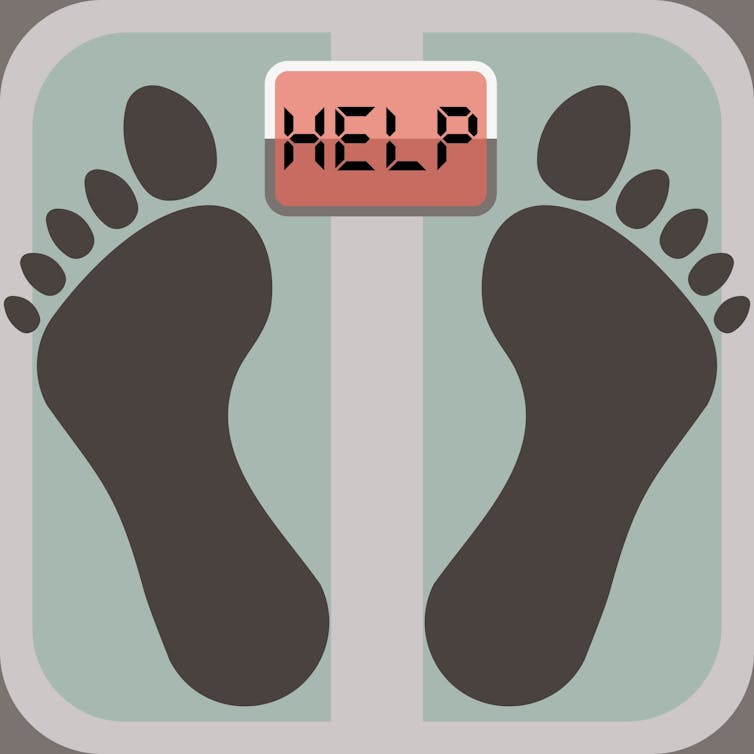Want to lose weight? Train the brain, not the body – CWEB.com

Scale image via shutterstock.com
Laurel Mellin, University of California, San Francisco
Despite massive government, medical and individual efforts to win the war on obesity, 71 percent of Americans are overweight. The average adult is 24 pounds heavier today than in 1960. Our growing girth adds some US$200 billion per year to our health care expenditure, amounting to a severe health crisis.
Drug research has not yielded a pill that helps people lose weight and keep it off. Traditional approaches such as diet and exercise can work short-term, but people almost inevitably regain the weight. Randomized controlled trials of weight loss surgery have shown some improvements in diabetes but not in mortality, cancer and cardiovascular disease.
If there is ever to be a “pill” — a solution to weight — it will be changing the brain, particularly the primitive areas of the brain, the “emotional brain” or mammalian and reptilian brain. These areas house circuits that control stress and our stress-fueled emotions, thoughts and behaviors. These circuits can be rewired in humans so by changing them, we have a chance to address the root cause of stress-related problems, including obesity. While some overweight and obesity are caused by genetic make-up, more and more research is indicating that stress plays a big role in weight gain. Many people under stress turn to food for comfort.
My colleagues and I set out to develop a neuroscience-based approach to weight management and dealing with the common excesses we all face, through emotional brain training. The idea was to use neuroscience-based tools to change the brain so that the whole range of common excesses would fade. The method has shown promising results.
The emotional brain is command central for weight and common excesses. It includes the fear, reward and starvation centers. When that brain is in stress, all three centers promote overeating and weight gain. We have strong drives to do exactly what we know we shouldn’t do. We can’t help it! Our emotional brain is in stress.
That stress ramps up the reward value of food, increases hunger for carbohydrates and decreases metabolic rate, almost ensuring weight gain. The stress-obesity link has been well-documented. Our thinking brain (neocortex) goes off line, and the extremes of our emotional brain calls the shots.
To take care of your body, take care of your brain

via www.shutterstock.com
The first step in taking control of our weight is to destress the emotional brain. In emotional brain training (EBT), we release stress by checking in several times throughout the day, identifying our level of stress and using the technique for that stress level to “spiral up” to a state of well-being.
There are five levels of stress and five tools. To get an idea of how they work, take a few breaths, check in with yourself and identify your stress level. Then use the tools for that level of stress to reduce your stress rapidly.
1. Compassion Tool (Stress Level 1 – Very Low Stress)
Say to yourself, “Feel compassion for myself,” then wait for a wave of compassion to flow through your body. Next say, “Feel compassion for others,” and feel a slight wave of warmth. Last, say, “Feel compassion for all living beings.”
2. Feelings Tool (Stress Level 2 – Low Stress)
Ask yourself, “How do I feel?” Often, three feelings bubble up, but wait long enough so that one feeling is the strongest. That’s the one! Next ask yourself, “What do I need?” and, finally, “Do I need support?”
3. Flow Tool (Stress Level 3 – A Little Stress)
Say the words: “I feel angry that …” and watch what words arrive in your mind to complete the sentence. State the sentence again, for seven more feelings: sad, afraid, guilty, grateful, happy, secure and proud. Notice the glow in your body and how your stress is gone. Why? When we feel our negative feelings, they fade. We are no longer in peril and the brain naturally focuses on positive feelings that give us the energy to move forward and do good things in our life.
4. Cycle Tool (Stress Level 4 – High Stress)
Start by stating what is bothering you (don’t hold back!), then protest that stress by saying “I feel angry that … I can’t stand it that … I hate it that … .” and each time watch what words arrive in your mind. This can unlock the circuit so that you can change at a deeper level. Pause and take a few deep breaths, then say the words: “I feel sad that … I feel afraid that … I feel guilty that …” and watch what words arrive in your mind to complete each sentence.
Next support yourself, and say, “OF COURSE I could do that (such as overeat) because my unreasonable expectation is … ” and again wait for words to bubble up from your unconscious mind, such as: “I get my safety from overeating.” That’s just an old glitch of a memory that needs updating. So, update it! Say the opposite expectation (such as “I cannot get my safety from food … I can get my safety from connecting to myself”). As you stated this when the circuit was freshly unlocked, the circuit can change into the expectation of your choosing. As the new expectation becomes dominant, the emotional drives for various excesses (including food) can begin to fade so that changing behavior becomes easier.
5. Damage Control Tool (Stress Level 5 – Very High Stress)
When we’re that stressed, we need to be held and comforted. Sometimes just rocking in your chair or breathing deeply helps. Also, you can say calming words repeatedly: “Do not judge. Minimize harm. Know it will pass. After all, it’s just stress and it will fade.”
Survival circuits activate strong emotional drives to overeat
Once you’ve started releasing stress from your emotional brain, chances are you’ll notice that you still get triggered sometimes. You might even blame yourself for that late night binge or that mindless eating. Actually, it’s just a survival circuit.
They are encoded when we are stressed and reach for food to cope. The brain remembers that food “saved us” from stress, so it encodes an expectation, such as “I get my safety from food.” That circuit can be replayed for a lifetime, fueling maladaptive eating.
Research now shows that these survival circuits can be rewired and we do that in EBT. In fact, they can only be rewired when we are stressed. Only then does the circuit unlock and make change more lasting. When stressed and craving food, the EBT user reaches for a tool rather than for the food and uses it to stop the craving and change the circuit. The drive to overeat fades.
The last step: Keeping the weight off
Keeping weight off is hard but it may be easier if we improve the brain’s emotional setpoint. Often a setpoint in stress is encoded from adverse experiences early in life and causes chronic stress overload in the emotional brain, a set up for weight regain.
![]() The solution is to move up the emotional setpoint, so we get the emotional brain out of chronic stress, which is why the EBT program is aimed at raising the setpoint, so participants are more resilient to new stresses, less likely to regain the weight they have lost and, most of all, to experience more joy in their daily lives.
The solution is to move up the emotional setpoint, so we get the emotional brain out of chronic stress, which is why the EBT program is aimed at raising the setpoint, so participants are more resilient to new stresses, less likely to regain the weight they have lost and, most of all, to experience more joy in their daily lives.
Laurel Mellin, Associate Clinical Professor of Family & Community Medicine and Pediatrics, University of California, San Francisco
This article was originally published on The Conversation. Read the original article.
Read Full Article and Videos CWEB.com – Trending News, Blog, Shopping


